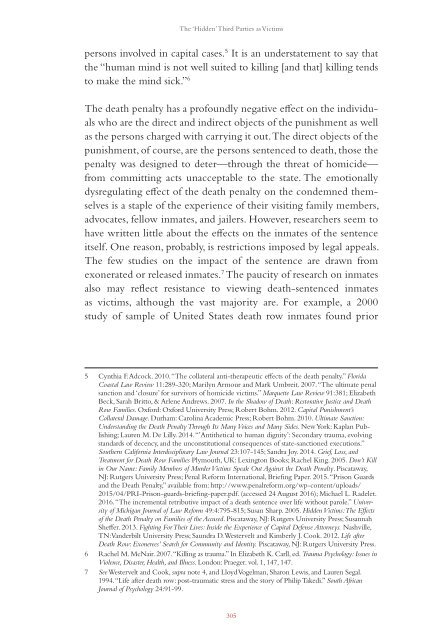DEATH PENALTY
KtXz304WP2b
KtXz304WP2b
Create successful ePaper yourself
Turn your PDF publications into a flip-book with our unique Google optimized e-Paper software.
The ‘Hidden’ Third Parties as Victims<br />
persons involved in capital cases. 5 It is an understatement to say that<br />
the “human mind is not well suited to killing [and that] killing tends<br />
to make the mind sick.” 6<br />
The death penalty has a profoundly negative effect on the individuals<br />
who are the direct and indirect objects of the punishment as well<br />
as the persons charged with carrying it out. The direct objects of the<br />
punishment, of course, are the persons sentenced to death, those the<br />
penalty was designed to deter—through the threat of homicide—<br />
from committing acts unacceptable to the state. The emotionally<br />
dysregulating effect of the death penalty on the condemned themselves<br />
is a staple of the experience of their visiting family members,<br />
advocates, fellow inmates, and jailers. However, researchers seem to<br />
have written little about the effects on the inmates of the sentence<br />
itself. One reason, probably, is restrictions imposed by legal appeals.<br />
The few studies on the impact of the sentence are drawn from<br />
exonerated or released inmates. 7 The paucity of research on inmates<br />
also may reflect resistance to viewing death-sentenced inmates<br />
as victims, although the vast majority are. For example, a 2000<br />
study of sample of United States death row inmates found prior<br />
5 Cynthia F. Adcock. 2010. “The collateral anti-therapeutic effects of the death penalty.” Florida<br />
Coastal Law Review 11:289-320; Marilyn Armour and Mark Umbreit. 2007. “The ultimate penal<br />
sanction and ‘closure’ for survivors of homicide victims.” Marquette Law Review 91:381; Elizabeth<br />
Beck, Sarah Britto, & Arlene Andrews. 2007. In the Shadow of Death: Restorative Justice and Death<br />
Row Families. Oxford: Oxford University Press; Robert Bohm. 2012. Capital Punishment’s<br />
Collateral Damage. Durham: Carolina Academic Press; Robert Bohm. 2010. Ultimate Sanction:<br />
Understanding the Death Penalty Through Its Many Voices and Many Sides. New York: Kaplan Publishing;<br />
Lauren M. De Lilly. 2014. “’Antithetical to human dignity’: Secondary trauma, evolving<br />
standards of decency, and the unconstitutional consequences of state-sanctioned executions.”<br />
Southern California Interdisciplinary Law Journal 23:107-145; Sandra Joy. 2014. Grief, Loss, and<br />
Treatment for Death Row Families Plymouth, UK: Lexington Books; Rachel King. 2005. Don’t Kill<br />
in Our Name: Family Members of Murder Victims Speak Out Against the Death Penalty. Piscataway,<br />
NJ: Rutgers University Press; Penal Reform International, Briefing Paper. 2015. “Prison Guards<br />
and the Death Penalty,” available from: http://www.penalreform.org/wp-content/uploads/<br />
2015/04/PRI-Prison-guards-briefing-paper.pdf. (accessed 24 August 2016); Michael L. Radelet.<br />
2016. “The incremental retributive impact of a death sentence over life without parole.” University<br />
of Michigan Journal of Law Reform 49:4:795-815; Susan Sharp. 2005. Hidden Victims: The Effects<br />
of the Death Penalty on Families of the Accused. Piscataway, NJ: Rutgers University Press; Susannah<br />
Sheffer. 2013. Fighting For Their Lives: Inside the Experience of Capital Defense Attorneys. Nashville,<br />
TN: Vanderbilt University Press; Saundra D. Westervelt and Kimberly J. Cook. 2012. Life after<br />
Death Row: Exonerees’ Search for Community and Identity. Piscataway, NJ: Rutgers University Press.<br />
6 Rachel M. McNair. 2007. “Killing as trauma.” In Elizabeth K. Carll, ed. Trauma Psychology: Issues in<br />
Violence, Disaster, Health, and Illness. London: Praeger. vol. 1, 147, 147.<br />
7 See Westervelt and Cook, supra note 4, and Lloyd Vogelman, Sharon Lewis, and Lauren Segal.<br />
1994. “Life after death row: post-traumatic stress and the story of Philip Takedi.” South African<br />
Journal of Psychology 24:91-99.<br />
305


